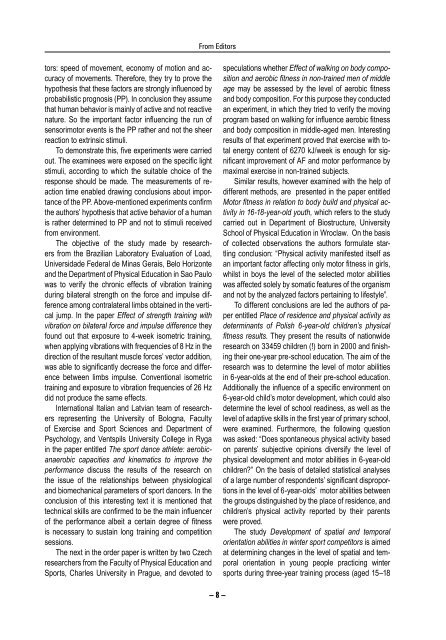Antropomotoryka nr 55.indb - Akademia Wychowania Fizycznego w ...
Antropomotoryka nr 55.indb - Akademia Wychowania Fizycznego w ...
Antropomotoryka nr 55.indb - Akademia Wychowania Fizycznego w ...
Create successful ePaper yourself
Turn your PDF publications into a flip-book with our unique Google optimized e-Paper software.
From Editors<br />
tors: speed of movement, economy of motion and accuracy<br />
of movements. Therefore, they try to prove the<br />
hypothesis that these factors are strongly influenced by<br />
probabilistic prognosis (PP). In conclusion they assume<br />
that human behavior is mainly of active and not reactive<br />
nature. So the important factor influencing the run of<br />
sensorimotor events is the PP rather and not the sheer<br />
reaction to extrinsic stimuli.<br />
To demonstrate this, five experiments were carried<br />
out. The examinees were exposed on the specific light<br />
stimuli, according to which the suitable choice of the<br />
response should be made. The measurements of reaction<br />
time enabled drawing conclusions about importance<br />
of the PP. Above-mentioned experiments confirm<br />
the authors’ hypothesis that active behavior of a human<br />
is rather determined to PP and not to stimuli received<br />
from environment.<br />
The objective of the study made by researchers<br />
from the Brazilian Laboratory Evaluation of Load,<br />
Universidade Federal de Minas Gerais, Belo Horizonte<br />
and the Department of Physical Education in Sao Paulo<br />
was to verify the chronic effects of vibration training<br />
during bilateral strength on the force and impulse difference<br />
among contralateral limbs obtained in the vertical<br />
jump. In the paper Effect of strength training with<br />
vibration on bilateral force and impulse difference they<br />
found out that exposure to 4-week isometric training,<br />
when applying vibrations with frequencies of 8 Hz in the<br />
direction of the resultant muscle forces’ vector addition,<br />
was able to significantly decrease the force and difference<br />
between limbs impulse. Conventional isometric<br />
training and exposure to vibration frequencies of 26 Hz<br />
did not produce the same effects.<br />
International Italian and Latvian team of researchers<br />
representing the University of Bologna, Faculty<br />
of Exercise and Sport Sciences and Department of<br />
Psychology, and Ventspils University College in Ryga<br />
in the paper entitled The sport dance athlete: aerobicanaerobic<br />
capacities and kinematics to improve the<br />
performance discuss the results of the research on<br />
the issue of the relationships between physiological<br />
and biomechanical parameters of sport dancers. In the<br />
conclusion of this interesting text it is mentioned that<br />
technical skills are confirmed to be the main influencer<br />
of the performance albeit a certain degree of fitness<br />
is necessary to sustain long training and competition<br />
sessions.<br />
The next in the order paper is written by two Czech<br />
researchers from the Faculty of Physical Education and<br />
Sports, Charles University in Prague, and devoted to<br />
speculations whether Effect of walking on body composition<br />
and aerobic fitness in non-trained men of middle<br />
age may be assessed by the level of aerobic fitness<br />
and body composition. For this purpose they conducted<br />
an experiment, in which they tried to verify the moving<br />
program based on walking for influence aerobic fitness<br />
and body composition in middle-aged men. Interesting<br />
results of that experiment proved that exercise with total<br />
energy content of 6270 kJ/week is enough for significant<br />
improvement of AF and motor performance by<br />
maximal exercise in non-trained subjects.<br />
Similar results, however examined with the help of<br />
different methods, are presented in the paper entitled<br />
Motor fitness in relation to body build and physical activity<br />
in 16-18-year-old youth, which refers to the study<br />
carried out in Department of Biostructure, University<br />
School of Physical Education in Wroclaw. On the basis<br />
of collected observations the authors formulate startling<br />
conclusion: “Physical activity manifested itself as<br />
an important factor affecting only motor fitness in girls,<br />
whilst in boys the level of the selected motor abilities<br />
was affected solely by somatic features of the organism<br />
and not by the analyzed factors pertaining to lifestyle”.<br />
To different conclusions are led the authors of paper<br />
entitled Place of residence and physical activity as<br />
determinants of Polish 6-year-old children’s physical<br />
fitness results. They present the results of nationwide<br />
research on 33459 children (!) born in 2000 and finishing<br />
their one-year pre-school education. The aim of the<br />
research was to determine the level of motor abilities<br />
in 6-year-olds at the end of their pre-school education.<br />
Additionally the influence of a specific environment on<br />
6-year-old child’s motor development, which could also<br />
determine the level of school readiness, as well as the<br />
level of adaptive skills in the first year of primary school,<br />
were examined. Furthermore, the following question<br />
was asked: “Does spontaneous physical activity based<br />
on parents’ subjective opinions diversify the level of<br />
physical development and motor abilities in 6-year-old<br />
children?” On the basis of detailed statistical analyses<br />
of a large number of respondents’ significant disproportions<br />
in the level of 6-year-olds’ motor abilities between<br />
the groups distinguished by the place of residence, and<br />
children’s physical activity reported by their parents<br />
were proved.<br />
The study Development of spatial and temporal<br />
orientation abilities in winter sport competitors is aimed<br />
at determining changes in the level of spatial and temporal<br />
orientation in young people practicing winter<br />
sports during three-year training process (aged 15–18<br />
– 8 –





![Antropomotoryka nr 57 [2012]. - Akademia Wychowania Fizycznego ...](https://img.yumpu.com/50213388/1/182x260/antropomotoryka-nr-57-2012-akademia-wychowania-fizycznego-.jpg?quality=85)











